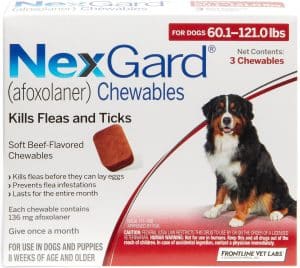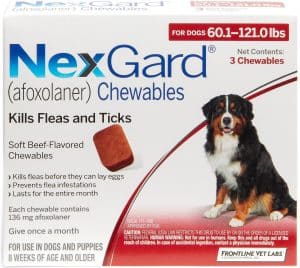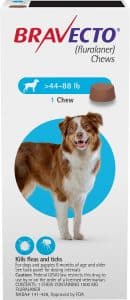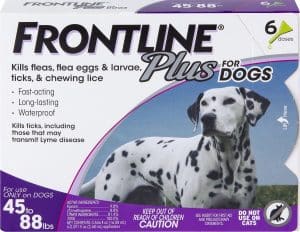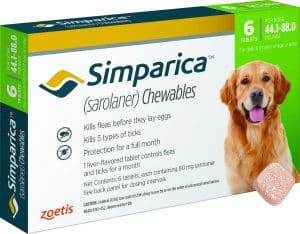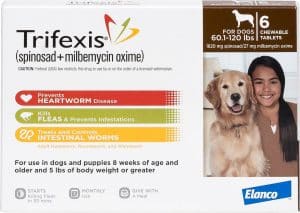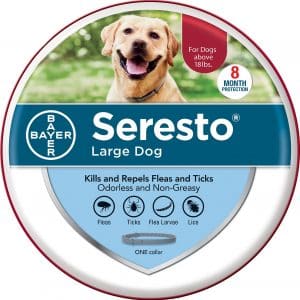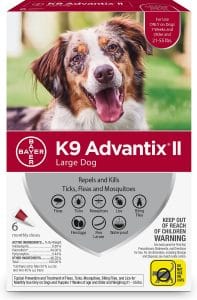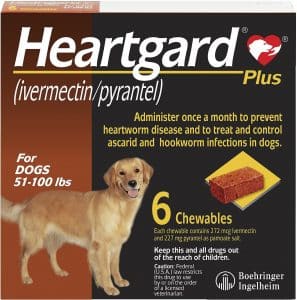Fleas! Pesky fleas! Not to mention ticks! No pawrent wants their pooch to suffer so if you find evidence of these parasitic passengers you immediately reach for treatment…but how to choose?!
There’s a vast array of flea and tick treatment and preventative medications, it can be overwhelming trying to choose the best one for your pet’s lifestyle. Don’t worry, FluentWoof has got you covered, simply read on through our NexGard review to learn more and help you choose if NexGard may be right for your pooch.
NexGard: Key takeaways
- NexGard is a delicious beef-flavored chew available on prescription to treat flea and tick infestations.
- Persisting in your pet’s body for 30-days after ingestion, NexGard contains the active ingredient, afoxolaner.
- NexGard is safe to use in puppies over 8 weeks old that weigh at least 4lbs.
NexGard Pros and Cons
No product is perfect for every pet, and NexGard is no exception to this. Let’s have a look at NexGard’s features to help you choose if it’s the right product for your fur-baby.
Pros
- NexGard is the only flea and tick control product licensed to prevent Lymes disease in pets (1).
- Delicious beef flavor that pets love, even more than comparable brands such as Simparica (2) or Bravecto (3).
- Gentle on the system, NexGard is safe to use on puppies as young as 8 weeks, and as light as 4lbs.
Cons
- NexGard has some adverse reactions reported, most commonly vomiting, itching, diarrhea and loss of appetite.
- NexGard’s active ingredient, afoxolaner, is a member of the isoxazoline drug class which has been implicated in seizures in dogs.
- The safety of NexGard has not been evaluated in breeding, pregnant or lactating dogs.
Consulting Your Vet
NexGard is only available through your veterinary surgeon or on prescription. Before using any medication, you should consult with your veterinarian to ensure NexGard is the best for your pet.
Your veterinarian may advise against NexGard if your pooch has previously had seizures or has been diagnosed with any neurological disorder including epilepsy.
NexGard Story & Background
Manufactured by the long established Merial Animal Health (now part of Boehringer Ingelheim), NexGard was approved by the Food and Drug Administration (FDA) in 2013 and in 2018 became the first (and only) product licensed to prevent Borrelia burgdorferi (Lyme disease) infections through killing the Ixodes scapularis tick (commonly known as black-legged or deer ticks) (1).
NexGard In-depth review
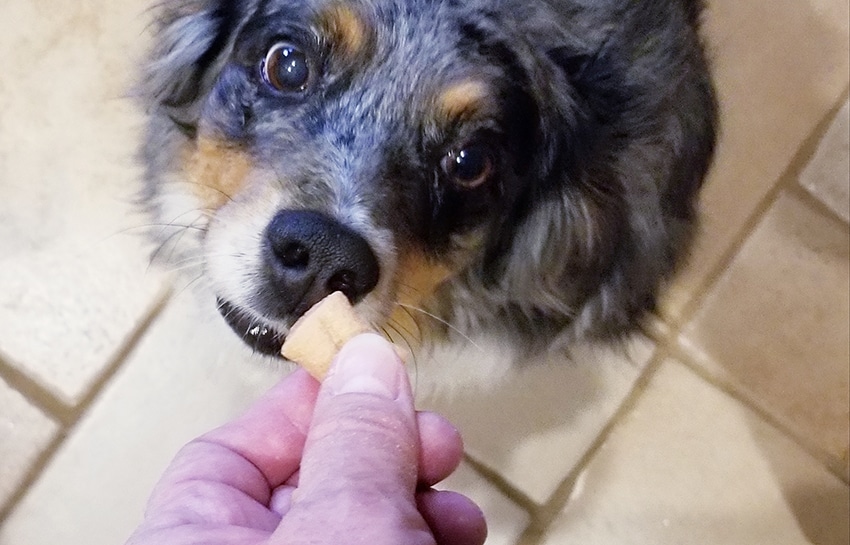
Now, let’s take a deep dive into NexGard, so you can make an informed decision about your pet’s flea and tick treatment.
What is NexGard?
NexGard is an oral flea and tick control product containing afoxolaner which was the first drug in the isoxazoline class of parasiticides. These beef flavored chewable tablets have also been shown to prevent Lyme disease in dogs.
What does it kill?
NexGard’s active ingredient, afoxolaner kills fleas and a number of tick species. Ticks killed include the Black-legged ticks, American Dog ticks, Lone star ticks and Brown Dog ticks. Though only approved for flea and tick control in the USA, NexGard has been approved to treat demodectic and sarcoptic mange infestations in Europe (4).
How Does NexGard work?
NexGard chewable tablets are given to pets as a tasty treat where they are absorbed through the lining of the small intestine into your pup’s blood stream where it is then stored underneath the skin until a parasite bites. Afoxolaner, the active ingredient in NexGard, kills adult fleas before they can lay eggs on your pet’s fur. Adult ticks are killed when they attach for a meal.
NexGard acts by binding to nerve cells in the flea or tick, blocking their communication, causing over-excitation of the bug’s nervous system which leads to their deaths.
NexGard active ingredients: What’s In It?
Active Ingredient: Afoxolaner
Afoxolaner is the only active ingredient in NexGard and has both acaricidal (tick-killing) and insecticidal (insect-killing) properties. It is the first member of the isoxazoline family to be discovered and is a relatively new molecule, only becoming available in 2013. It has been shown to be 100% effective against fleas within 24-hours of administration and over 90% effective within 72-hours against all targeted tick species (5).
Is NexGard safe for your dog?
Yes, NexGard is safe for the majority of dogs, in fact clinical safety studies found no significant ill effects in puppies administered 5 times the recommended dose. Vomiting was seen during the study, though this was also seen in placebo patients.
A field study was also carried out administering NexGard to patients receiving other medicines including vaccines, anti-inflammatories, antibiotics and anesthetics. This study found no adverse effects in these patients.
Is NexGard Safe for Pregnant dogs?
The safety of NexGard hasn’t been evaluated or approved for use in pregnant dogs.
Benefits
Aside from the obvious benefit of eliminating flea and tick infestations, NexGard is also effective against demodectic and sarcoptic mange. Administered in a yummy beef-flavored, soft, chewable tablet, most pets readily gulp it down, and you only need to give it once a month. You can give it alone or with a meal, if your pooch is a fussy-fido, you can even hide it in their favorite treats.
Fleas start to die within 4 hours of administration and NexGard kills all fleas that land on your pet within 8 hours – that’s pretty fast! In fact, fleas are killed so fast they don’t lay eggs in your pet’s fur, this breaking the life cycle. There’s over 90% effectiveness against ticks within 72 hours of administration and NexGard has been shown to prevent infection with Lyme disease in dogs exposed to deer or black-legged ticks.
NexGard is safe for all breeds of dog once they weigh more than 4lb. It can even be given to puppies just 8 weeks of age and elderly pooches. It’s been proven safe to use with other medications including antibiotics and anti-inflammatories. Since NexGard is an oral preventative and treatment, you don’t have to separate your pooch from other members of the family after administration.
Types of NexGard
NexGard and NexGard Spectra are the two products in the range; both products target fleas and ticks. NexGard Spectra also contains milbemycin oxime which protects against intestinal worms and heartworm.
NexGard Spectra is not currently available in the USA, but is available in Europe.
NexGard Chewables for Dogs
NexGard chewable tablets, containing afoxolaner are tasty treatments for pets to both treat and protect against flea and tick infestations. It’s even active against demodectic and sarcoptic mange.
Application:
NexGard is easily administered in a single oral dose for your pup. Simply give your pooch one of these delicious beef-flavored chews and they’ll be protected within 4 hours. If your pup is really fussy, you can always hide the chew in their favorite treat or in their meal.
How quickly does NexGard chewables work?
This flea and tick treatment starts to work within 30-minutes of administration and fleas start to die within 4 hours, with over 99% killed within just 8 hours of administration. Black-legged/Deer ticks and American Dog ticks are killed within 48 hours of infestation while it takes just 72 hours to kill Lone Star ticks following infestation.
How long does it last for?
NexGard is effective for 4 to 6 weeks following administration. Some pets with liver or kidney disorders may have therapeutic levels of the drug in their system for longer than this (6).
How Are the Ingredients in NexGard chewables for dogs delivered?
These tasty chewable tablets are easily administered as a treat or with a meal. Once digestion is started in the stomach, the active ingredient, afoxolaner is absorbed through the intestines into the bloodstream where it is then distributed throughout the body.
What we like about it
- Suitable to give to pets of all ages, including puppies just 8 weeks old once they weigh more than 4lbs.
- Starts to work within 30 minutes and fleas start to die within just 4 hours.
- NexGard is the only product approved to prevent Lyme disease through killing Black-legged/Deer ticks.
- Tasty chewable treat with beef flavoring makes it really easy to protect your pet against fleas and ticks.
what we don’t like about it
- Afoxolaner is a member of the isoxazoline class of parasiticides which may cause seizures in some pets.
- Hasn’t been approved for use in breeding, pregnant or lactating dogs.
A Vet’s note: NexGard is a great product to protect your pooch against flea and tick infestations. Fast-acting, it starts to work within just 30 minutes of administration, and giving it to your pup is really easy as most pets love the beef-flavoring. Safe for all breeds, I have prescribed this product a number of times to pets of all ages and sizes. Due to the fact that it’s a member of the isoxazoline class of anti-parasitics, I tend to not advise its use in pets with epilepsy or that have had seizures previously.
NexGard Spectra
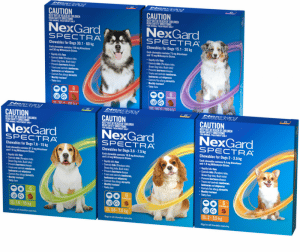
While NexGard was released in 2013, a similar product NexGard Spectra was launched in Europe in 2015 and Australia in 2017. NexGard Spectra combines afoxolaner with milbemycin oxime which is an anti-helminth (anti-worm) medication (4). Spectra provides almost complete parasite protection for pets, but is not currently available in the USA.
What we like about it
- Just one treatment protects your pup against fleas, ticks, heartworm and intestinal worms.
- Tasty treat-like chew that pets love, so it’s easy to administer their month medication.
- Pets of all ages can receive NexGard Spectra once they are at least 8 weeks and weigh 4lbs.
- Safe to handle your pet immediately after administration, and your pet can swim and be bathed without interfering with the product’s efficacy.
What we don’t like about it
- As a member of the isoxazoline anti-parasiticide family, afoxolaner has been implicated in causing seizures in rare cases.
- Milbemycin oxime may interact with some medications such as the chemotherapeutic medication doxorubicin.
A Vet’s note: NexGard Spectra is an easily administered treatment that protects against both external and internal parasites, so I often prescribe this (in the EU) to pets that are difficult to pill, have skin issues or even to just reduce the amount of physical medications a pet needs to receive.
Dosage: How Much Will Your Dog Need?

As NexGard Spectra is not available in the USA, we will just focus on NexGard chewables for this. Treatments are available in weight-band chewables, simply weigh your pup and select the appropriate sized chew.
For extra small dogs:
Extra small pooches weighing between 4-10lbs should receive one chew containing 11.3mg of Afoxolaner each month.
For small dogs:
Dogs weighing between 10.1-24lbs should receive a single 28.3mg chew every 30 days.
For medium dogs:
Puppers weighing 24.1-60lbs need one chew containing 68mg of afoxolaner every 30 days.
For Large dogs:
If your dog weighs 60.1lbs-121lbs, then just one 136mg chew per month is suitable.
For Extra-Large dogs:
Pets weighing over 121lbs should receive an appropriate combination of smaller pet chewables.
NexGard side effects
So, what’s the downside to the product? All products can have adverse effects and NexGard is no exception to this. Luckily, adverse effects are rare, we’ve listed them here in decreasing order of frequency. When side effects do occur, they tend to be short-lived and resolve without intervention but if your pet does suffer from one of these effects, you should contact your veterinarian for advice.
Gastrointestinal signs: These include vomiting, diarrhea and loss of appetite and impact up to 4% of pets. Vomiting is possibly the most commonly reported adverse effect to taking NexGard. Even if a pet doesn’t experience vomiting, they may be a little inappetent if feeling nauseated. Most pets only experience these signs after their first dose and not subsequent doses.
Skin Reactions: Some pets occasionally experience intense itchiness (pruritus), reddened skin and thus develop some degree of dermatitis Allergic reactions are rare but generally appear as hives or swelling in localized areas such as around the face or muzzle.
Neurological Signs: The rarest adverse effects (thankfully) are neurological signs such as seizures and tremors. Seizures are possibly more likely to occur in dogs that have a history of epilepsy or other neurological diagnoses but have also been reported in pets without any such history.
Effectiveness
So, does NexGard really work? In short, yes. It’s important to note that many of the studies regarding its efficacy have been performed with connection to the manufacturer.
In a 2014 study, oral afoxolaner showed over 99.9% efficacy against adult fleas within 24 hours of administration and this persisted for 5 weeks (7). One study showed that within just 4 hours of administration, fleas start to die with over 99% killed within 8 hours of ingesting NexGard. Subsequent evaluations of flea eggs showed that pets who received NexGard were unable to lay eggs on dogs, thus breaking the life cycle (8).
A 2014 investigation into the efficacy of afoxolaner against black-legged ticks found that NexGard had a 98.4% efficacy within 48 hours and persisted with over 94% efficacy one month later (9). This indicates that a single dose of NexGard can rapidly eliminate an existing tick infestation while providing residual protection for a further month (9). Another study investigating Brown dog ticks found that NexGard caused up to 98.8-100% death of ticks within 48 hours of administration while protection of over 95.7% lasted over a further 5 weeks (10).
Is NexGard Safe for Dogs?
Broadly speaking, yes. Safety studies funded by Merial Animal Health found that there were no clinically-relevant effects in puppies that received 5 times the maximum advised dose for 6 treatments. Even pets that were receiving concomitant medications showed no evidence of drug interaction or adverse effects (8).
Despite these studies, there are many sites online claiming that NexGard kills pet dogs, however, to date, no links could be conclusively proven. The FDA states that NexGard “continues to be safe and effective for the majority of animals”. Adverse effects are those that occur in close administration of a product (usually within a few hours); these may be related but don’t mean that the reaction is caused by NexGard. If your pet experiences a reaction, you should contact your veterinarian for advice, to examine your fur-baby and report the possible reaction to the manufacturer.
Where to buy NexGard online?
NexGard is available to purchase in a variety of online stores, including Chewy.com. NexGard is a prescription only product which you will need from your veterinarian in order to purchase online. If an online store doesn’t need a prescription then they’re illegitimate and the product you purchase may be counterfeit.
How Much Does NexGard Cost?
While prices vary depending on the store, NexGard costs in the region of $20 per month.
Alternatives for dogs – How Does NexGard Compare to Other Flea & Ticks products ?
Obviously, NexGard isn’t the only product on the market, so we’ve put together some product comparisons to help you choose the best for your fur-baby.
NexGard vs Bravecto
NexGard and Bravecto both contain active ingredients from the isoxazoline class of anti-parasitic drugs so they have a similar action on the bug’s nervous system to cause their death. Afoxolaner (NexGard) was the first discovered of these drugs though both it and Bravecto (fluralaner) were launched in the same year. Both products are palatable chews, though Bravecto is also available in a topical treatment. Bravecto and NexGard both target fleas within 24 hours and ticks within 48-72 hours after administration (11).
One large difference is the duration of action, Bravecto persists in the system for 12 weeks, while NexGard lasts 1 month, both have their merits. Using Bravecto means that you don’t have to give your pet medication each month, however if your pup suffers an adverse reaction then the active ingredient in Bravecto is persistent in their body for three times longer than NexGard. NexGard is safe to give to puppies just 8 weeks old once they weigh over 4lbs, however Bravecto should only be given to puppies after 6 months.
Frontline Vs NexGard
Frontline contains fipronil in a topical “spot-on” while NexGard chewable active ingredient is afoxolaner. Both target fleas and ticks, with NexGard killing over 99% of fleas within just 8 hours while Frontline requires a further 4 hours to take effect. NexGard and Frontline both target adult fleas, while parasites need to bite your pet to be killed using NexGard, they are killed on contact with your pet when using Frontline, further reducing the risk of your pet contracting a nasty disease such as Lyme disease from ticks.
NexGard is delivered in an oral chew so your pet doesn’t have to be separated from others in the household and there’s no interference from bathing or swimming on your pet. Frontline however is a topical product so your pup would need to be separated from other pets to prevent them grooming the product away while it’s being absorbed. Frontline’s efficacy may be slightly reduced by bathing or swimming and your pet shouldn’t get wet for 48 hours after application.
Comfortis Vs NexGard
Comfortis is another chewable tablet that targets fleas, it contains spinosad which is an insecticide derived from the bacteria Saccharopolyspora spinosa. Spinosad causes involuntary tremors, paralysis and subsequent death of the flea. NexGard’s active ingredient afoxolaner also targets the parasite’s nervous system. One major difference between Comfortis and NexGard is that NexGard is also active against four species of tick, while Comfortis has no activity against ticks.
Both beef-flavored chewables are fast acting, with spinosad killing 100% of fleas within 4 hours while NexGard kills 100% of fleas within 24 hours (12). Both products last for one month and both are suitable for puppies, NexGard for puppies at least 8 weeks old and Comfortis those at least 14 weeks old.
Simparica Vs NexGard
The active ingredients in Simparica and NexGard are both members of the isoxazoline drug class and are active against both fleas and ticks. Simparica contains sarolaner which kills over 99% of fleas within 8 hours and action lasts for at least 4 weeks; NexGard, containing afoxolaner displays a similar action though is a little slower than sarolaner (13). Simparica is approved for use in pups over 6 months old, while NexGard is suitable for use in younger puppies from 8 weeks once they weigh more than 4lbs.
Regarding ticks, Simparica starts to kill ticks within 8 hours and is effective against 5 types of ticks, including Amblyomma maculatum (Gulf Coast tick), compared to NexGard which targets 4 tick species. One study has shown Simparica to be effective at preventing Lyme disease, however only NexGard is approved by the FDA for this purpose.
Trifexis Vs NexGard
Trifexis is a product that targets both endo- (internal) and ecto-parasites (external) through the active ingredients milbemycin oxime and spinosad respectively. NexGard contains afoxolaner which isn’t effective against internal parasites but does target and kill both fleas and ticks, Trifexis is only active against fleas. Both are easily administered beef-flavored medications that persist for a whole month and both are approved for puppies once they are 8 weeks of age, though they should weigh over 5lbs for Trifexis while puppies just 4lbs can receive NexGard.
Seresto Vs NexGard
Seresto is a collar impregnated with imidacloprid and flumethrin to control flea and tick infestations that your pet must wear every day and is protective for up to 8 months in comparison to NexGard, the oral chewables that are administered monthly to your pet. Seresto protects against two ticks, the American dog tick and the Lone Star tick while NexGard also targets Brown dog ticks and Black-legged ticks, thus providing broader protection.
NexGard is also the only product approved by the FDA to prevent Lyme disease in dogs. One study found that Seresto collars were possibly more effective at repelling the target ticks when worn, compared with NexGard.
Aside from ticks, Seresto also targets fleas and their larvae (NexGard kills flea adults only), sarcoptic mange and chewing lice. NexGard’s active ingredient afoxolaner is also effective against demodectic and sarcoptic mange, but not chewing lice.
K9 Advantix II Vs NexGard
K9 Advantix II is a topical “spot-on” containing permethrin, imidacloprid and pyriproxyfen that targets fleas, ticks, mosquitoes, lice and biting flies that is applied monthly. As it kills through contact of the parasite with your pet’s fur, there’s no need to bite which helps to prevent the transmission of diseases to your pup. It targets all life stages of fleas, unlike NexGard which only targets adult fleas.
After you treat your pet with NexGard there’s no need to isolate them from companion pets, however if you have a cat in the house and you choose to use K9 Advantix II then you must keep them apart until the product has completely been absorbed and dried.
NexGard vs HeartGard Plus
HeartGard isn’t actually an alternative to NexGard but used together, these products work to prevent both internal and external parasites in your pet. HeartGard contains ivermectin and pyrantel which protects against heart-, hook- and roundworms while NexGard protects your pet against fleas and ticks.
Both products are tasty beef-flavored chews that should be given monthly to give your pet the best protection. Manufactured by Boehringer Ingelheim, formerly Merial Animal Health, it’s safe to administer both products together to your pet without increasing the risks of adverse effects.
F.A.Q
Q: Is NexGard prescription only?
A: Yes, NexGard is only available through your veterinarian or with a prescription if you prefer to purchase online.
Q: Can NexGard kill my dog?
A: NexGard is considered safe, otherwise it wouldn’t have received FDA approval for its use in pets and your veterinarian will never advise you to use a dangerous product on your pet.
Q: Is NexGard for fleas and ticks?
A: Yes, NexGard targets adult fleas before they can lay eggs and 4 types of ticks including the Black-legged tick, Lone Star tick, Brown dog tick and American dog tick.
Q: Is there a recall on NexGard?
A: No, the product has not been recalled. In 2018 (and updated in 2019) the FDA issued a statement advising owners of the potential for adverse neurological effects in some pets following the use of isoxazoline class medications (16).
Q: Can NexGard make dogs sick?
A: Any medication may cause adverse effects including vomiting in some pets but luckily the incidence of these are uncommon.
Q: Does NexGard cause neurological problems?
A: There is a risk of NexGard causing neurological problems following administration including muscle tremors, ataxia (incoordination) and seizures. The risk of these are very low, but if your pet has had neurological signs previously then your veterinarian may advise against NexGard for them.
Q: Can I buy NexGard over the counter?
A: No, NexGard is available on prescription only. If you are purchasing online and the company states that a prescription is not required then there is a chance that the product is counterfeit.
Q: Do ticks fall off after NexGard?
A: Yes, once a tick takes a blood meal and ingests the active ingredient, afoxolaner their nervous system is targeted and then falls off.
Q: Can a dog still get fleas with NexGard?
A: Fleas can still land on your pet, but once they bite and ingest afoxolaner they are then killed before they can lay eggs.
Q: Does NexGard kill eggs?
A: No, NexGard kills adult fleas only, but it kills so rapidly that fleas don’t have the opportunity to lay eggs.
Q: Does NexGard kill all stages of fleas?
A: No, NexGard targets adult fleas only, but it breaks their life cycle through the rapid killing of these fleas before they can lay any eggs.
Q: How long does NexGard stay in a dog’s system?
A: NexGard persists in your pet’s body for between 4-6 weeks, though this may be longer in pets that have concurrent kidney or liver disorders.
Q: Does NexGard cause seizures in dogs?
A: There have been reports of medicines in the isoxazoline class of parasiticides being related to seizures in some pets. The active ingredient in NexGard, afoxolaner is one of these.
Q: What if my dog throws up after taking NexGard?
A: If your pet throws up within 2 hours of administration then you should contact your veterinarian as they may require a further dose. If, however, they throw up after 2 hours, then the medication should have been fully absorbed and no further treatment should be required.
Q: Does NexGard kill ear mites?
A: Though not licensed for the treatment of ear mite infestations, NexGard can reliably eliminate them with a single treatment (17).
Q: Does NexGard make dogs sleepy?
A: In general, no but occasionally some pets may feel a little tired after receiving their treatment. This should pass over the following hours.
Q: Can dogs overdose on NexGard?
A: Yes, it’s possible to overdose your dog on NexGard, though thankfully this is unlikely due to its wide safety margin but if your pup has had more than their recommended dose (per the weight bracket) then you should contact your veterinarian immediately.
Q: Does NexGard protect against mosquitoes?
A: No, NexGard doesn’t protect against mosquito bites.
Q: Does expired NexGard still work?
A: There is no guarantee that an expired NexGard will be effective for your pet.
Q: How do I get my dog to eat NexGard?
A: The majority of pups will gulp down the tasty beef flavored chews but if your pet is fussy, you can hide it in their favorite treat or mix it with their food.
Q: Can ticks still bite with NexGard?
A: Yes, in fact for a tick to be killed, they must bite your pet to ingest the active ingredient.
Q: What is the generic name for NexGard?
A: Afoxolaner is the active ingredient and generic name for NexGard.
Q: Can I give my dog half a NexGard?
A: No, you shouldn’t give your dog half a NexGard. Due to manufacturing processes the medication may not be evenly distributed throughout the chew and so your pet may not receive a suitable dose if they don’t receive the full chew.
Q: How often do you give NexGard?
A: NexGard should be given to your pet once per month.
Q: How fast do ticks die with NexGard?
A: All targeted ticks die within 72 hours of administration.
Q: Can a dog get Lyme disease while on NexGard?
A: NexGard is the only product licensed to prevent Lyme disease through the control of the Black-legged tick.
Q: Does NexGard prevent heartworm?
A: No, NexGard has no activity against internal parasites, including heartworm.
Q: Can I give my dog NexGard and K9 Advantix II?
A: No, both of these products target fleas and ticks, making it unnecessary to administer both medications.
Q: Can I give Heartgard and NexGard together?
A: Yes, in fact the company advises that both products used together provide excellent protection for your pet against both internal and external parasites.
Q: Can a human take NexGard?
A: No, NexGard is not suitable for human consumption.
NexGard Rating
We give NexGard 4 out of 5!!
On the whole, NexGard is a safe product and as it lasts just one month in a pet’s system if your pet suffers any adverse effects they should be short-lived. This is in comparison to Bravecto which lasts 12 weeks in your pet’s system.
NexGard is also the only product licensed to prevent Lyme disease in dogs.

Conclusion: Is NexGard Legit? (And Probably Worth Trying)
Yes, certainly NexGard is legit, as this NexGard review should prove! As the FDA has previously reported, NexGard is considered safe for the majority of pets and your veterinarian will be able to advise you whether NexGard may be the right product for your pet.
As the only product licensed for the prevention of Lyme disease, NexGard is important for pets who are at an increased risk (those in areas with high Deer or Black-legged tick populations).
References:
- https://www.fda.gov/animal-veterinary/cvm-updates/fda-approves-nexgard-prevention-infections-cause-lyme-disease-dogs
- Carithers, D.S., L. Halos, J. Crawford, H. Stanford, W.R. Everett & S.J. Gross (2016). Comparison of preference demonstrated by dogs when offered two commercially available oral ectoparasiticide products containing either Afoxolaner (NexGardⓇ) or sarolaner (SimparicaTM). Intern J. Appl. Res. Vet. Med. 14(3).
- Halos, L., D.S. Carithers, R. Solanki, H. Stanford, S.J. Gross (2015). Preference of dogs between two commercially available oral formulations of ectoparasiticide containing isoxazolines, afoxolaner or fluralaner. Open J. Vet. Med. 5(2).
- https://www.ema.europa.eu/en/medicines/veterinary/EPAR/nexgard
- https://www.vin.com/apputil/image/handler.ashx?docid=8745872
- https://vcahospitals.com/know-your-pet/afoxolaner
- Hunter III, J.S., P. Dumont, T.S. Chester, D.R. Young, J.J. Fourie & D.L. Larsen (2014). Evaluation of the curative and preventative efficacy of a single oral administration of afoxolaner against cat flea Ctenocephalides felis infestations on dogs. Vet. Parasitol. 201(3-4).
- https://nexgardclinic.com/sites/default/files/NEXLymePI.pdf
- Mitchell, E.B., J.W. McCall, S.T. Chester & D. Larsen (2014). Efficacy of afoxolaner against Ixodes scapularis ticks in dogs. Vet. Parasitol. 201(3-4).
- Kunkle, B., S. Daly, P. Dumont, M. Drag & D. Larsen (2014). Assessment of the efficacy of orally administered afoxolaner against Rhipicephalus sanquineus sensu lato. Vet. Parasitol. 201(3-4).
- https://nexgardclinic.com/sites/default/files/NGvsBravecto-Chart_0.pdf
- https://www.comfortis.com/effectiveness#:~:text=Spinosad%2C%20the%20active%20ingredient%20in,before%20they%20can%20lay%20eggs.
- https://www.bsavalibrary.com/docserver/fulltext/10.22233/9781910443446/9781910443446.56.4.pdf?expires=1602072825&id=id&accname=guest&checksum=182F09FD39A2C91AB1EB0C4A821BCE88
- Honsberger, N.A., R.H. Six, T.J. Heinz, A. Weber, S.P. Mahabir & T.C. Berg (2016). Efficacy of sarolaner in the prevention of Borrelia burgdorferi and Anaplasma phagocytophilum transmission from infected Ixodes scapularis to dogs. Vet. Parasitol. 222.
- Ohmes, C.M., J. Hostetler, W.L. Davis, T. Settje & W.R. Everett (2015) Comparative efficacy of an Imidacloprid/Flumethrin collar (SerestoⓇ) and an oral afoxolaner chewable (NexGardⓇ) against Tick (Dermacentor variabilis and Amblyomma americanum) infestations on dogs: a randomised controlled trial. Parasitol. Res. 114(1).
- https://www.fda.gov/animal-veterinary/cvm-updates/animal-drug-safety-communication-fda-alerts-pet-owners-and-veterinarians-about-potential-neurologic
- https://veterinarypartner.vin.com/default.aspx?pid=19239&catId=102899&id=4951535


